Author: Eve Leeks
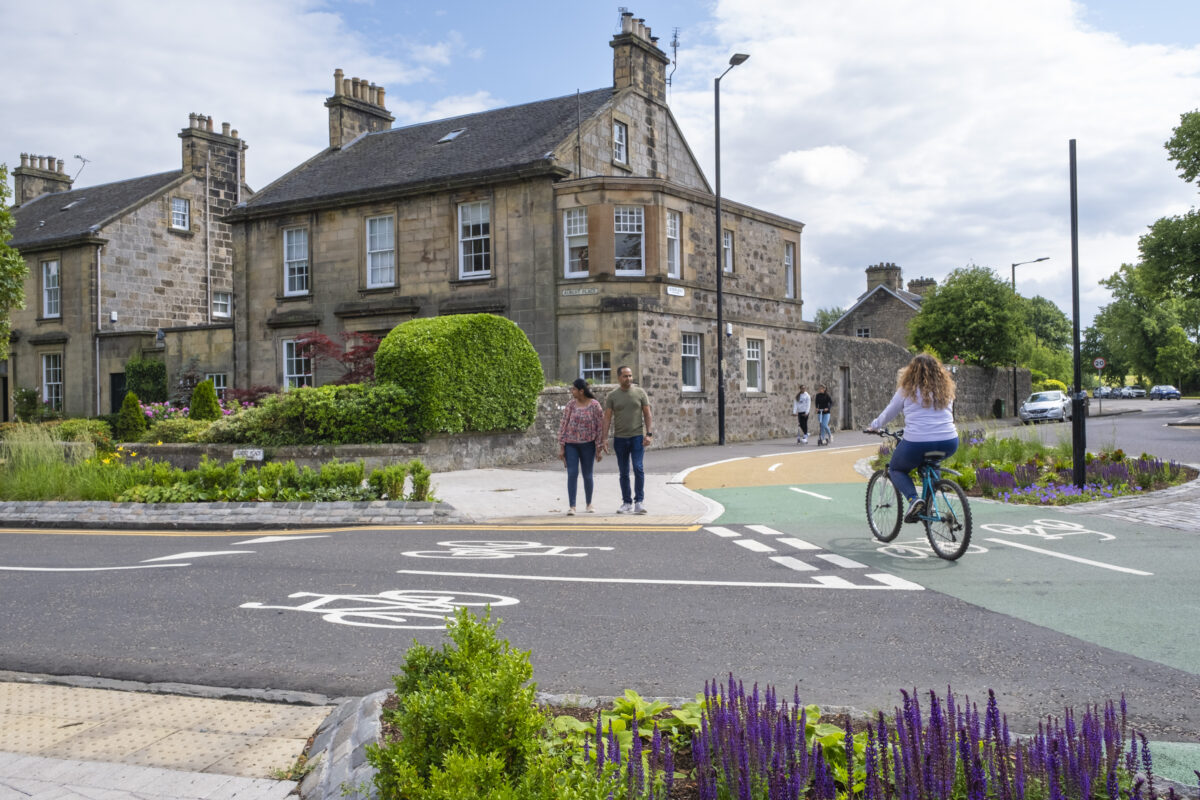
Increasing walking, wheeling, and cycling are all great ways improve physical and mental health.
However, active journeys are also a key part of the national response to the climate emergency, and our overall ambition to reach net zero carbon emissions.
Through Places for Everyone, Sustrans is working with partners all across Scotland to deliver safe and accessible active travel infrastructure.
This includes new connections linking up isolated rural communities as well as expansive city-wide networks to help people get where they need to go.
As part of this, we want to ensure that every one of our projects is delivered in as sustainable a way as possible to reduce our own carbon emissions.
So how can we do it?
Outlining the techniques
How we approach the design and procurement of construction materials during project delivery can have a big impact on our carbon output.
When delivering infrastructure, it is helpful to think about what we can avoid, what we switch to as an alternative, and also what we can improve in the process.
What to avoid
Reducing the need for new construction can significantly increase project sustainability.
This might mean finding different ways to meet your goals without building new infrastructure at all, or by simply making the most out of what already exists through reuse or repurposing.
This approach encourages us to think creatively and sustainably to minimize new constructions.
- Utilising existing pathways: Before considering new constructions, explore if there are existing pathways that can be renovated or repurposed to suit the needs of the project. This might include old railway paths commonly used by the National Cycle Network, or old bridges that are no longer suitable for heavy vehicles but can carry lower loads.
- Multi-purpose facilities: Rather than building new assets, we can design spaces that serve multiple purposes, thus reducing the overall need for new constructions.
- Community Engagement: Engaging with the community can sometimes reveal alternatives and local insights that help in avoiding new constructions. For instance, local communities might propose efficient ways to repurpose existing assets that outsiders might not be aware of.
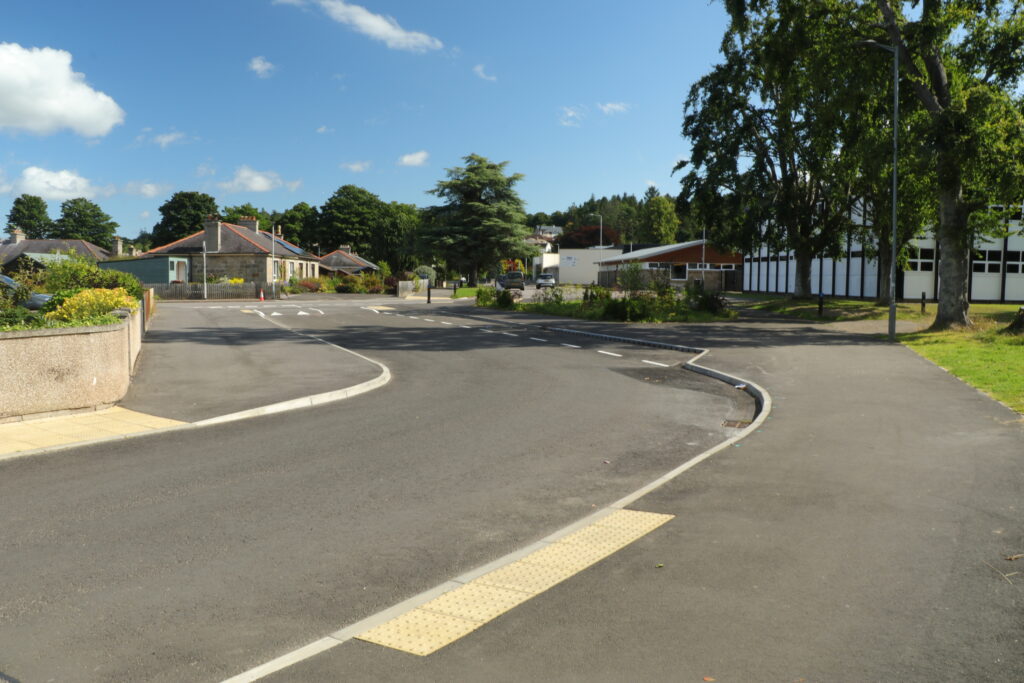
Forres Roysvale Park
In partnership with Moray Council, the Forres Roysvale Park project shows how excess road space can be used to implement sustainable drainage solutions. By narrowing the existing carriageway, a 3-metre-wide shared use path was introduced alongside tactical rain gardens. This not only provided a safe and direct link between Forres Academy and Applegrove primary and nearby residential areas, but also served to alleviate surface water issues.
Where to switch
Opting for alternatives without compromising on quality can result in major savings to your carbon footprint.
This might involve changing the project scope, redesigning the approach, choosing different materials, or technologies that are more eco-friendly.
- Sustainable Materials: Using recycled or recovered materials can significantly reduce the carbon emissions associated with the production of new materials.
- Low Carbon Technologies: Leveraging technologies that are more energy-efficient or that have a lower environmental impact, e.g., using electric plant vehicles used in construction.
- Nature-Based Solutions: Taking advantage of nature-based solutions, like creating green corridors which not only facilitate active travel but also enhance biodiversity.
- Permeable pavements: Using permeable pavements can aid in water management, reducing the need for separate drainage systems.

Loans to Troon Railway
In partnership with South Ayrshire Council and Ayrshire Roads Alliance, an all-new traffic-free route to join the settlements of Loans and Troon was completed in 2023. As well as providing a key active travel link, the Loans to Troon route is notable for being constructed from almost entirely recycled paving materials. This serves to create an affordable, long-lasting but also sustainable connection between key trip generators, such as Marr College and Troon train station.
How to improve
Increasing the sustainability of the materials being used for construction can sway the carbon output of a project significantly.
This can involve thinking about the longevity and durability of the materials being used and, ultimately, planning for its reuse or recycling.
- Circular Economy Principles: Applying circular economy principles might mean designing assets that can be easily dismantled and the materials reused or recycled, thereby reducing waste.
- Long-life, low maintenance materials: Reducing the need to maintain and increasing time before resurfacing is needed in the future will help reducing carbon emitted during the lifetime of an asset.
- Native landscaping: Integrate local plants alongside paths. These require less water and maintenance, sequester carbon, and enhance the appeal of the path, encouraging more use.
- Inclusive Design and Aesthetic Design: Ensuring the pathway is accessible to people of all ages and abilities not only promotes inclusivity but also encourages more people to use the pathway, potentially reducing carbon emissions from reduced car use. Making the pathway attractive, possibly through the inclusion of art installations or well-designed green spaces, can encourage more people to use it, fostering a sense of community while also reducing carbon emissions through reduced car usage.
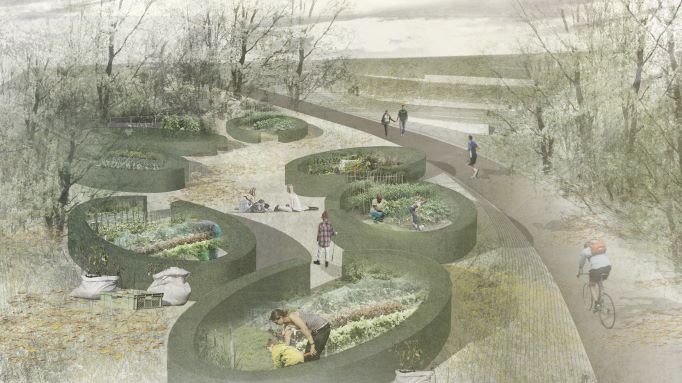
Roseburn to Union Canal
With the City of Edinburgh Council, work is underway to link the Union Canal with the North Edinburgh Path Network via a new traffic-free route. Inaccessible areas of decaying shrubland will be restored via tree planting and community gardens. This not only delivers a valuable connection from north to south, but also a new green corridor.
The above guidelines have been categorised according to the PAS 2080 Carbon Management in Infrastructure standard, which supports organisations wanting to lower emissions from their construction activities.
For further information, please see the Carbon Management in Buildings and Infrastructure report.
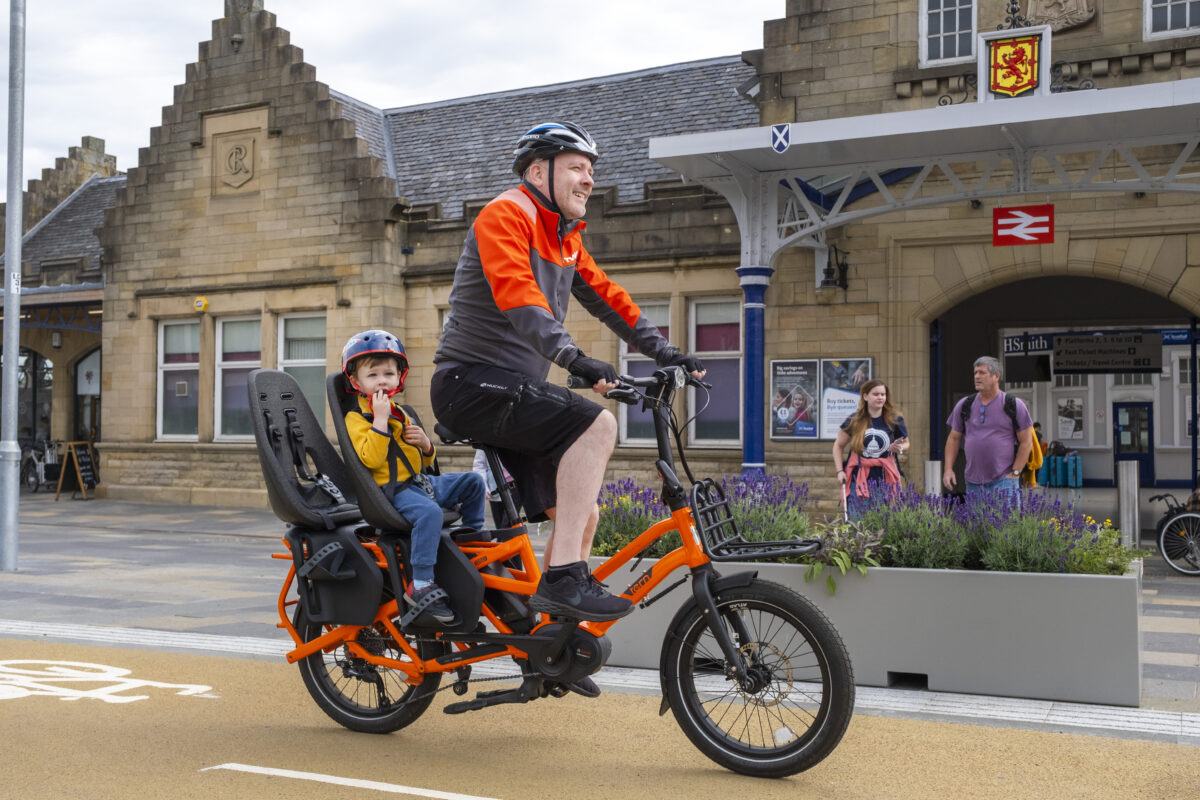
Across Scotland, 29% of households don’t have access to a car.
In our major cities, this figure rises to 46% of households in Glasgow and Dundee, and 41% in Edinburgh.
So what can we do to give everyone in Scotland fairer choices in how they get around? And how are we supporting communities in moving towards lower carbon, healthier and happier journeys?
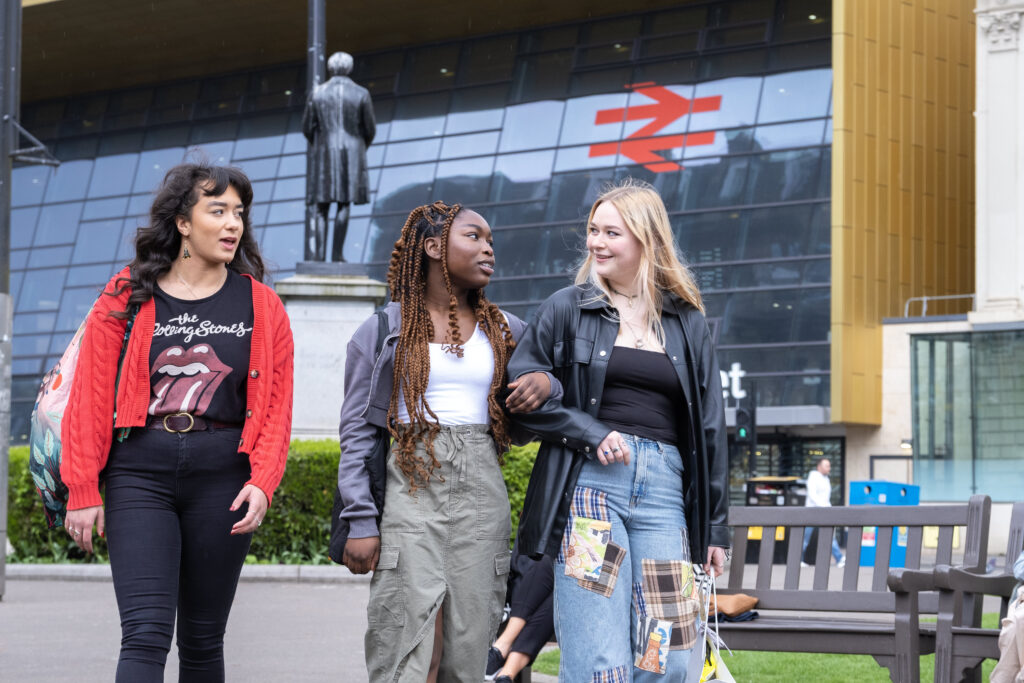
Increasing and improving the opportunities to walk, wheel and cycle for short, everyday journeys has a huge role to play.
But good, reliable public transport is vital for longer journeys to work, education, everyday amenities, and friends.
And most of these longer journeys already start and end with a walk, wheel or cycle to a stop or station.
With Scotland aiming to reduce car kilometres travelled by 20 per cent by 2030, we take a look at some of the ways we’re better connecting walking, wheeling and cycling with public transport across Scotland and making it easier to leave the car at home.
Stirling train station transformation
The regeneration of Stirling train station is a primary example of how access to train stations can be dramatically improved for walking, wheeling, and cycling.
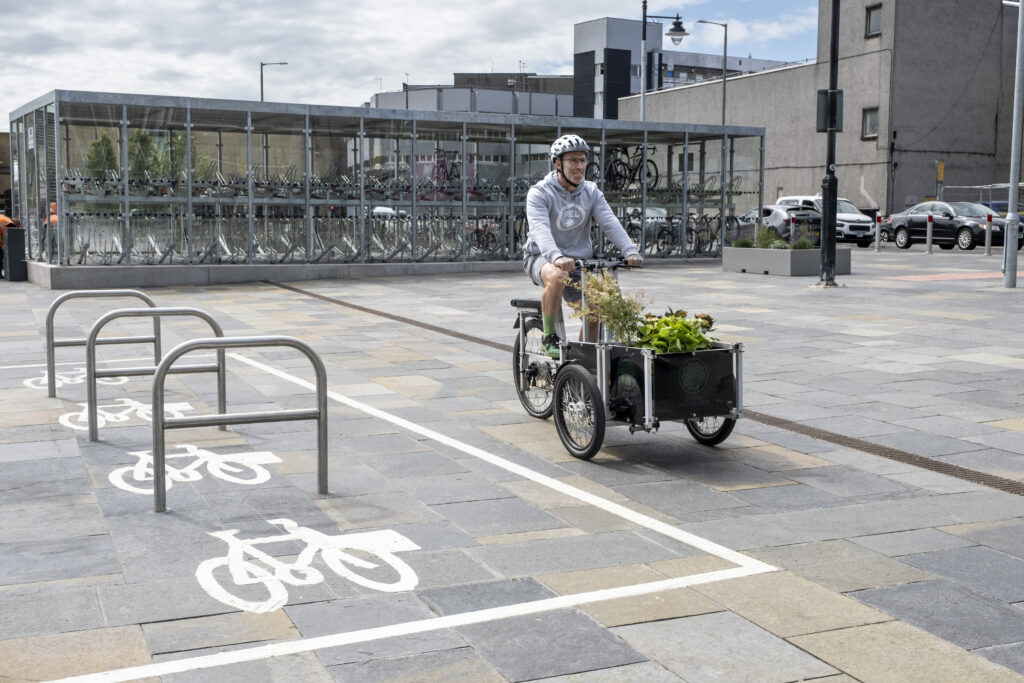
With funding provided through Places for Everyone and working closely with ScotRail, the ambitious £5m Stirling Station Gateway project delivered a complete re-design of the station forecourt.
Completed in June 2023, major changes include widened footways, comfortable seating areas, landscaping works, as well as improved signage and wayfinding points.
Another key feature is the increased provision of secure covered cycle storage, offering more than 140 additional cycle parking spaces and increasing the total number of cycle spaces at the station to more than 200.
A large portion of the space required for these improvements was been created via changes to the carriageway and the reallocation of the taxi rank to an adjacent street.
Importantly, access for blue badge holders has been entirely retained at the station, with additional spaces even being provided.
Perhaps one of the biggest successes of the project, however, is how well it interconnects with the wider Walk Cycle Live Stirling project via segregated cycleways along Gooscroft Road.
Delivered in partnership with Stirling Council via Places for Everyone, Walk Cycle Live Stirling aims to deliver a £9.5m city-wide active travel network.
Taken together, all this has helped transform the area from an unappealing vehicle-dominated environment to one which creates space for safer, and more accessible active travel options.
Bike spaces on Borders buses
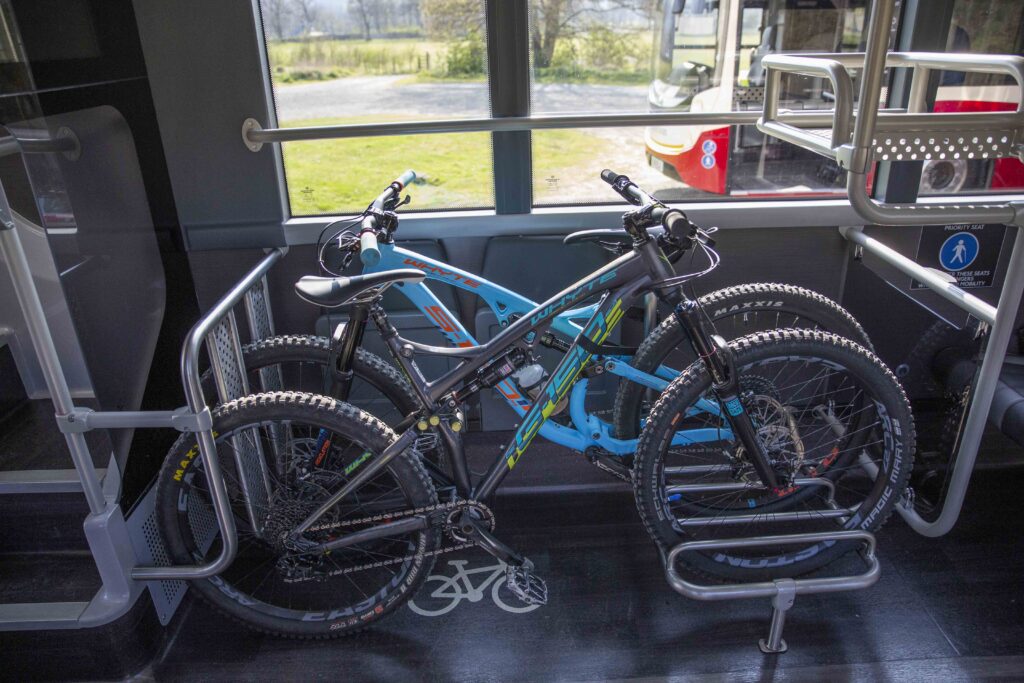
The work which Sustrans delivered with Borders Buses highlights how public transport can assist cyclists in making longer journeys without having to leave the bike behind.
With the novel creation of bike storage spaces on board, the X62 service, which serves Tweed Valley and the Scottish Borders, was able to become a fully bike-friendly route.
This involved retrofitting bike storage onto buses so that every bus operating on the X62 route would have space for a minimum of two bikes.
It also involved a change in livery, marketing and promotional materials with the aim to increase the catchment area of the bus service.
The money Sustrans provided resulted in a fully bike-friendly bus service that runs from Edinburgh to the Scottish Borders. By making buses bike-friendly, they become accessible to more people.
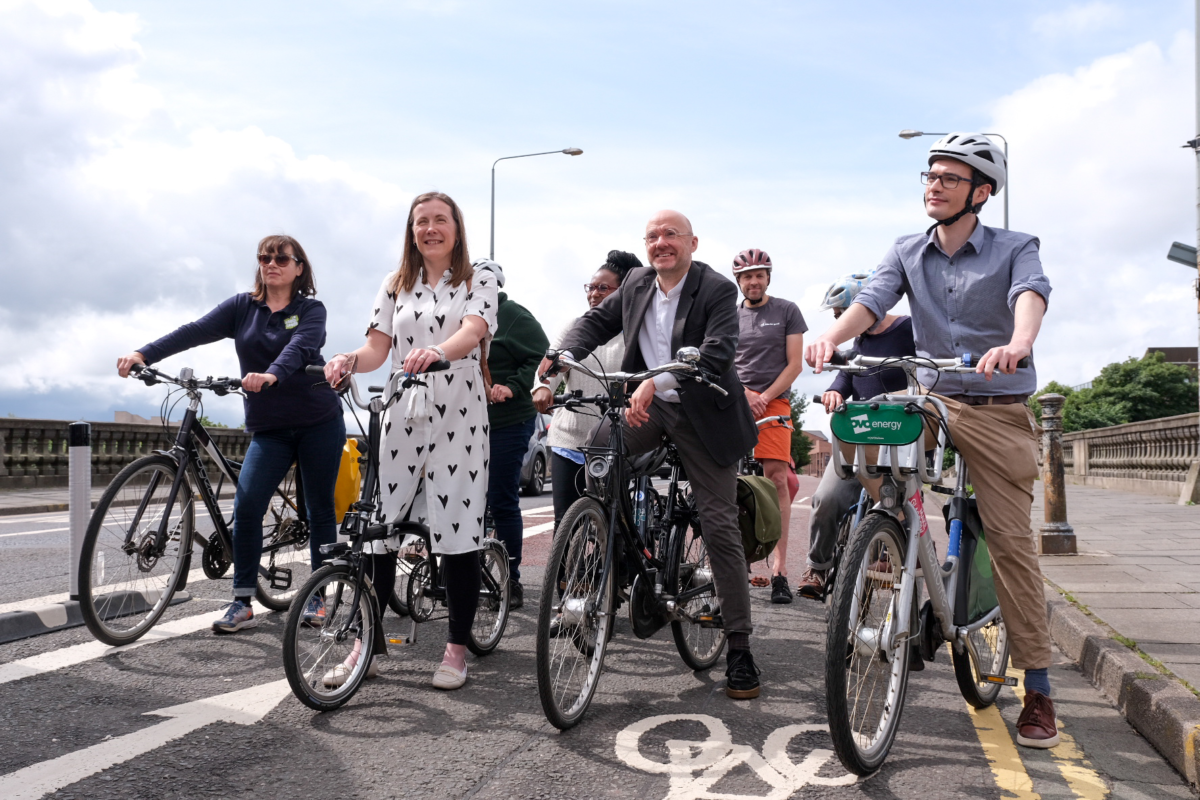
The South City Way has hit a major milestone by reaching Glasgow city centre.
To mark the occasion, the 2.5km route was officially opened by the Minister for Active Travel and members of the community on the 6 July 2023.
The fully-segregated, two-way cycle path has provided a high quality, direct and safe link between Glasgow’s southside and the city centre.
It’s making it easier than ever for more people in the area to leave the car at home and make healthier and happier everyday journeys.
The route is also expected to benefit trade through improved access to the area.
The project was made possible by over £3.5 million of funding from the Scottish Government through Sustrans Scotland’s Places for Everyone/Community Links PLUS programme.
Glasgow City Council used their own funding as a partial match, bringing the project total to around £7m.
Construction work started on the project in December 2017 and was completed up to the Clyde in June 2023.
What is the South City Way?
The new segregated route has created a vital and accessible active travel link for local communities.
The South City Way has connected key destinations such as hospitals and medical centres, parks, businesses, academic institutions and places of worship along the cycling corridor.
The project has also improved access to public transport in the area.
To make it safer and easier to walk and wheel, pavements have been resurfaced along large parts of the route, with new crossing points installed, existing crossings improved and traffic speeds slowed through the addition of raised tables on side roads.
These changes will make everyday walking, wheeling and cycling journeys safer, easier and more convenient for everyone.
The South City Way also connects with National Cycle Network Routes 7, 75 and 756 at the traffic-free Clyde-side path.
This opens up the possibility of longer trips heading east from Glasgow to Uddingston, East Kilbride and Rutherglen, and west to Clydebank, Bowling, Dumbarton, Loch Lomond and the Trossachs.
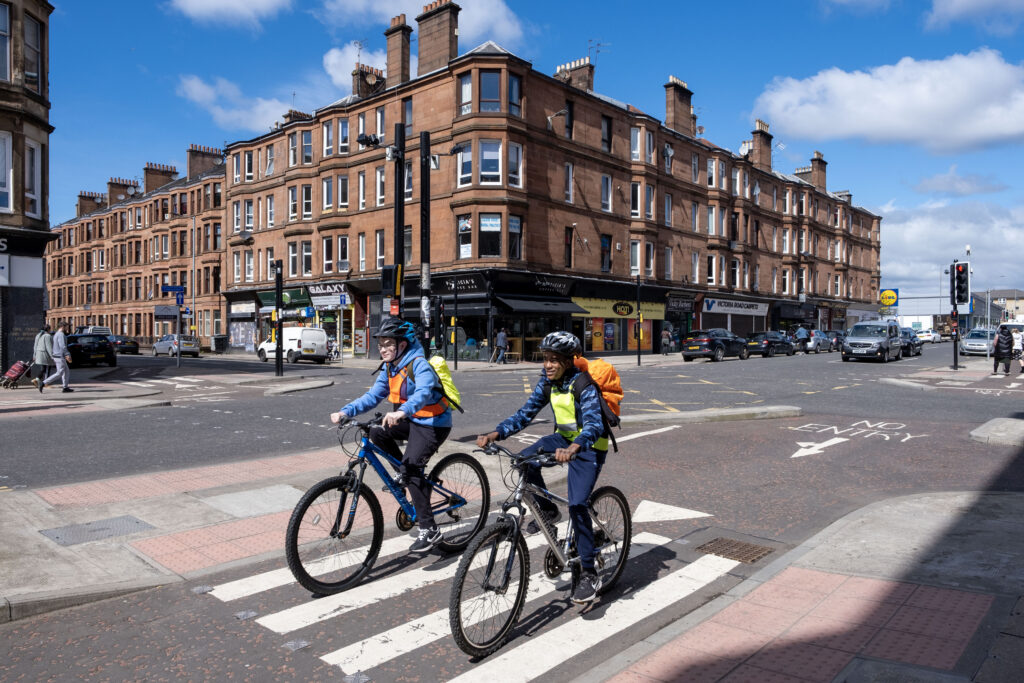
An innovative approach to active travel infrastructure
During the project, we worked closely with Glasgow City Council to trial two protected junctions at locations along Victoria Road.
These were the first protected junctions trialled in Scotland.
Protected junctions are road junctions that separate people travelling on foot, by cycle, and in vehicles.
The trial was successful, with our Research and Monitoring Unit finding that between March 2019 and September 2021, the total cycle traffic through the junctions almost doubled.
More than 935,000 cycle journeys have now been recorded on Glasgow’s South City Way cycle route in the past two years.
A project with community at its heart
The South City Way is about much more than the new connection to the city centre.
Businesses, community organisations and individuals have been at the heart of the project from the outset.
The creation of a Community Projects Trail featuring murals, bike locking facilities, planters and much more was supported by the South City Way Small Grants Fund and led by local groups.
This has helped make the active travel corridor an attractive, inclusive and welcoming space for everyone.
Representatives from the Hidden Gardens, Govanhill Baths Trust, Bike for Good, South Seeds and Crossroads Youth and Community Association joined the Minister for Active Travel, Patrick Harvie MSP, and officials from Glasgow City Council and Sustrans Scotland to celebrate the South City Way launch event on 6 July.
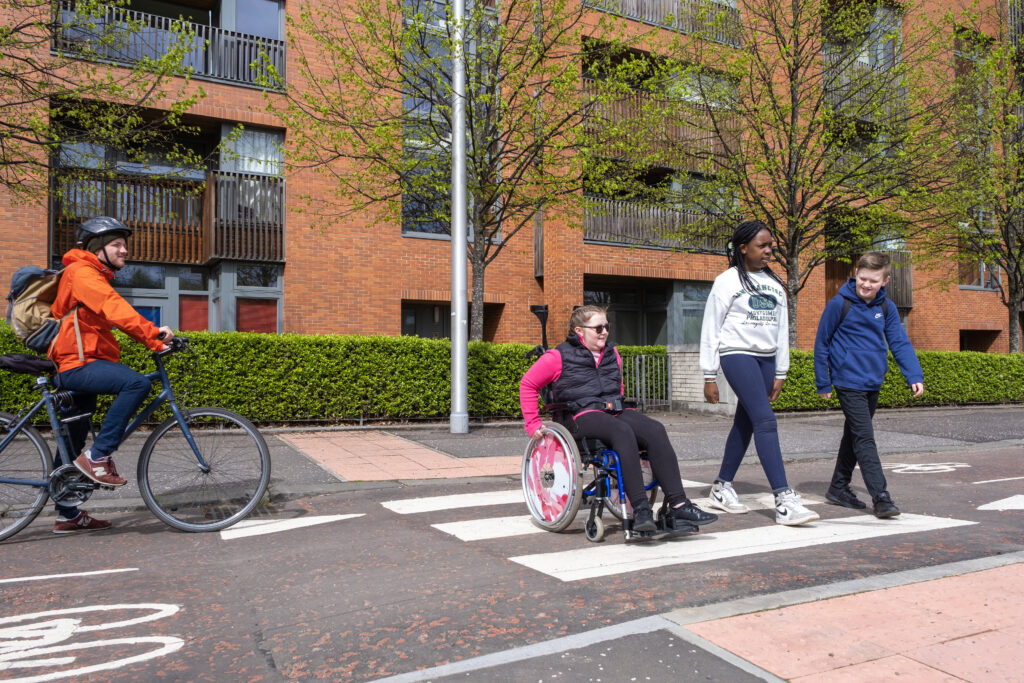
A cause for celebration
Speaking ahead of the event, Minister for Active Travel, Patrick Harvie MSP, said:
“I’m pleased to welcome the completion of the South City Way to Glasgow City centre.
We will soon see over a million cycle journeys on this new active travel corridor, which is yet another example of segregated infrastructure making it easier for people to walk, wheel and cycle for everyday journeys.With the eyes of the world on Scotland for the first ever UCI 2023 Cycling World Championships, it’s schemes like this which demonstrate the shared intent of Government and Local Authorities to make cycling safer and more convenient as a means of everyday transport.
For our health, wellbeing and environment, our ambition to deliver more infrastructure like this, right across the country, has never been higher.
That’s why the Scottish Government has committed to spending at least £320 million, or 10% of the total transport budget, on active travel by 2024‑25.”
Patrick Harvie MSP, Minister for Active Travel
Councillor Angus Millar highlighted the newly released cycle journey figures as clear evidence of the demand for improved cycling infrastructure in Glasgow:
“It’s great to see the difference the South City Way is making to cycling in the southside area of Glasgow.
The cycle journey figures are remarkable and show without doubt that people want to get about Glasgow more sustainably when infrastructure is available for them to do so.
Now that the South City Way has reached the city centre, I am confident the number of people cycling on the route will continue to grow.
Concerns about safety are the number one barrier to cycling and our work to ensure safe, segregated routes in all areas of Glasgow will support more people to choose cycling for everyday journeys across the city.
We will continue to work closely with the Scottish Government, Sustrans and communities across Glasgow as we deliver our commitment to create a comprehensive City Network for active travel over the course of the decade.”
Cllr Angus Millar, Glasgow City Council
Carole Patrick, Portfolio Director for Sustrans Scotland, added:
“The South City Way is about so much more than the new safe and direct connection to the city centre.
Working in partnership with Glasgow City Council through our Scottish Government-funded Places for Everyone programme, we are so proud of the fact that local communities have been at the heart of the project.
Businesses, community organisations and individuals have really embraced the opportunities for the southside.
The community-led projects supported by the Small Grants Fund have had such a powerful impact in making the South City Way corridor an attractive, inclusive and welcoming space for everyone.
Putting communities at the heart of projects and investing in safe, high-quality infrastructure which makes it easier to leave the car at home and walk, wheel or cycling for everyday journeys is a winning combination.
Monitoring in 2019 and 2021, before and after the innovative protected junctions were installed, recorded a 100% increase in cycling journeys – and recent sensor figures show that the South City Way is supporting and encouraging more and more people to make healthier and happier journey choices.
“We look forward to continuing to work with our partners at Glasgow City Council and the Scottish Government to build on the success of the South City Way and make it easier for even more people to walk, wheel and cycle.”
Carole Patrick, Portfolio Director, Sustrans Scotland
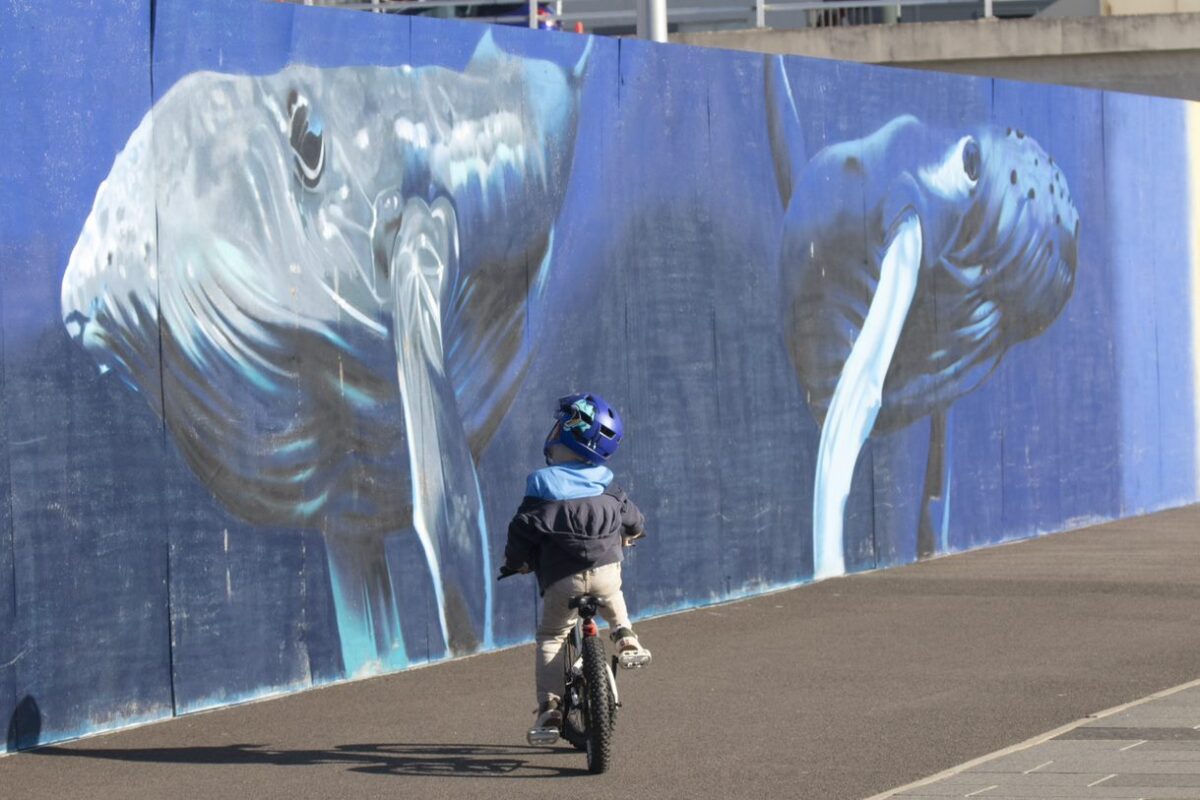
ArtRoots, supported by funding from the Scottish Government through Sustrans, works in partnership with local community groups to make artistic and aesthetic improvements in conjunction with PfE infrastructure projects in Scotland.
Do you have a PfE infrastructure project that could benefit from some artistic input?
- Think about your project, is it community-led?
- Are you a community organisation? To process an application we would need to see: 1. A signed constitution and 2. the required number of board members in accordance with your constitution.
- Do you think that the inclusion of an artwork could help the local community to become more interested in the project?
- Will an artwork such as a mural, sculpture or decorative seating for example encourage your local community to walk, wheel or cycle along your new path?
Find out more about the ArtRoots to see how your project could benefit and download the guidelines and application forms below
More information on ArtRoots
ArtRoots Fund Guidelines
ArtRoots Fund Application Form
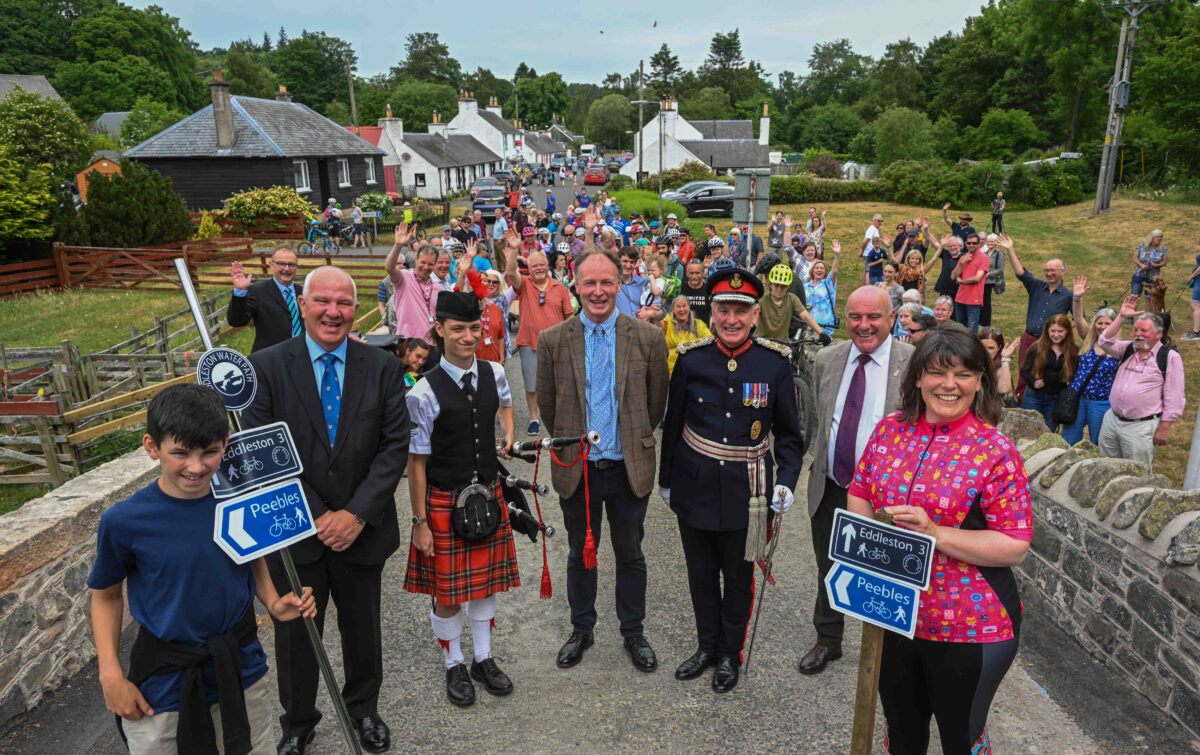
A vital rural link
A new off-road shared-use path between the county town of Peebles and the satellite village of Eddleston in the Scottish Borders officially opened on the 17th June 2023.
Spanning 6km in length, the Eddleston Water Path provides a convenient and accessible route for local people and visitors to the area to walk, wheel and cycle between the settlements, connecting communities, businesses and key services like never before.
The new path will also benefit equestrians in the area, providing a safe and more relaxed riding experience set back from the road.
The project was made possible by over £2 million of funding from the Scottish Government through Sustrans Scotland’s Places for Everyone programme and South of Scotland Enterprise (SOSE).
Construction work started on the project in late 2021 and was completed in early June 2023.
Community ambition in action
From the very beginning, the Eddleston Water Path project has been shaped by the ambitions of the local community.
Local groups and campaigners were instrumental in calling for improved active travel infrastructure in the area, having spent years promoting their vision for a healthier and more sustainable future.
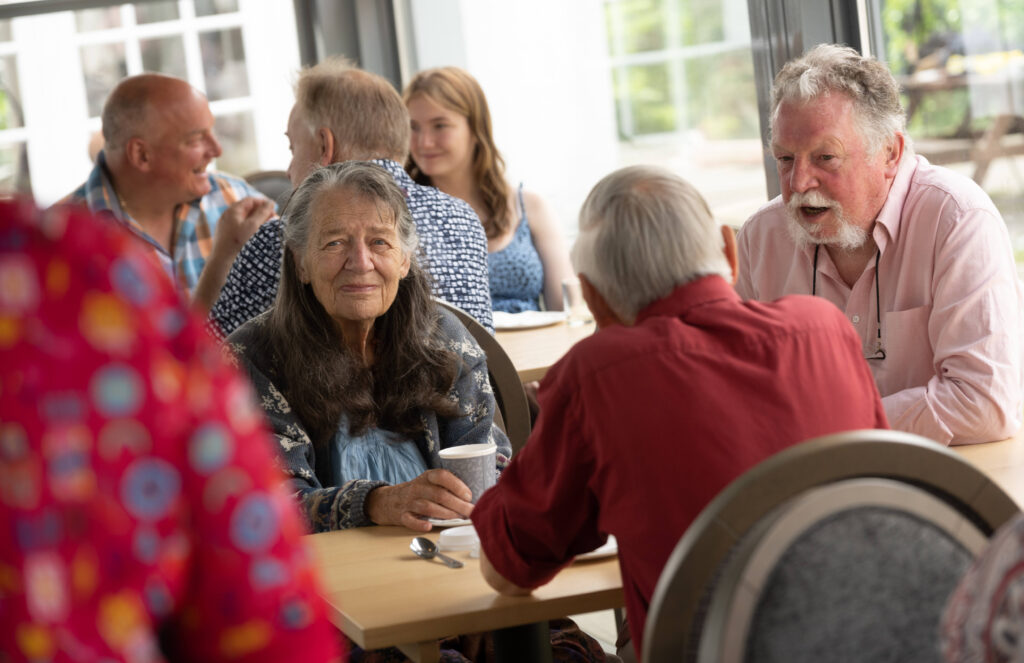
Peebles Community Trust (PCT) led the design of the project once funding was secured, and feedback was gathered at every stage to ensure the Eddleston Water Path reflected the needs and wants of residents.
This approach has resulted in the creation of a well-loved community asset which has provided affordable access to employment opportunities, key services and treasured greenspace.
Accessibility for everyone
Before the Eddleston Water Path was constructed, travelling between Peebles and Eddleston was only possible via a busy and fast-moving road.
Now complete, the project provides an alternative route where all residents and visitors to the area, regardless of age or ability, have the option to leave the car at home and walk, wheel and cycle instead.
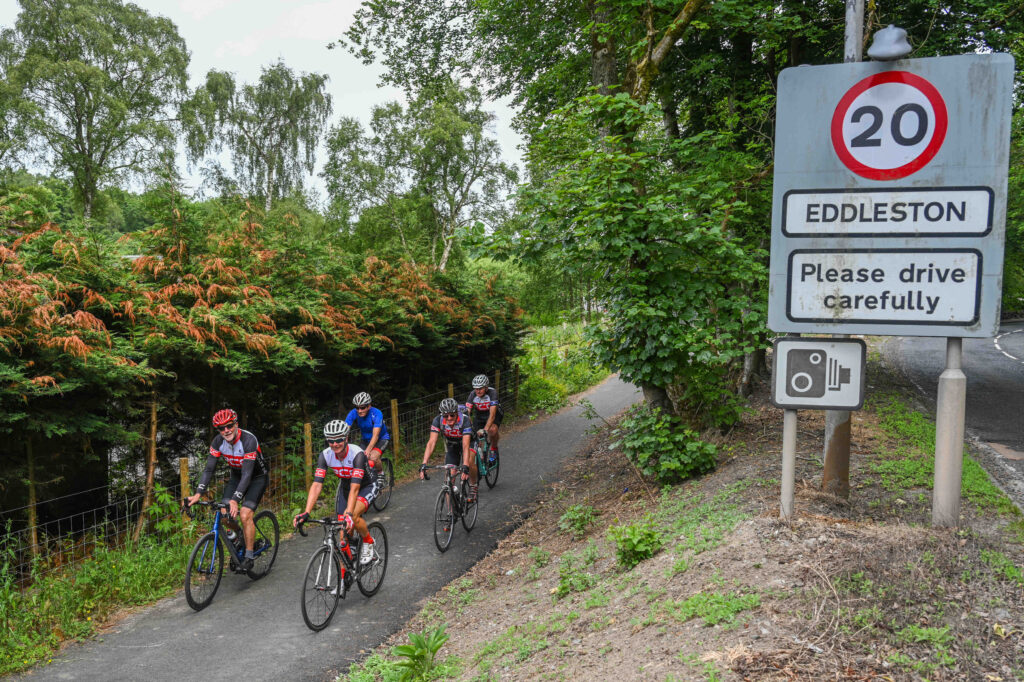
To futureproof the project, flood mitigation and measures to increase biodiversity were built into the designs.
The path has also contributed to the areas extensive network of paths for leisure and riding, linking into a wider network that includes the existing Tweed Valley Railway Path to the south.
A cause for celebration
The Eddleston Water Path was officially opened on the 17th June 2023 at an event attended by local residents, project partners and elected representatives.
Following a series of speeches, a piped procession was laid on for those in attendance before the ribbon was cut by local primary school student Conor.
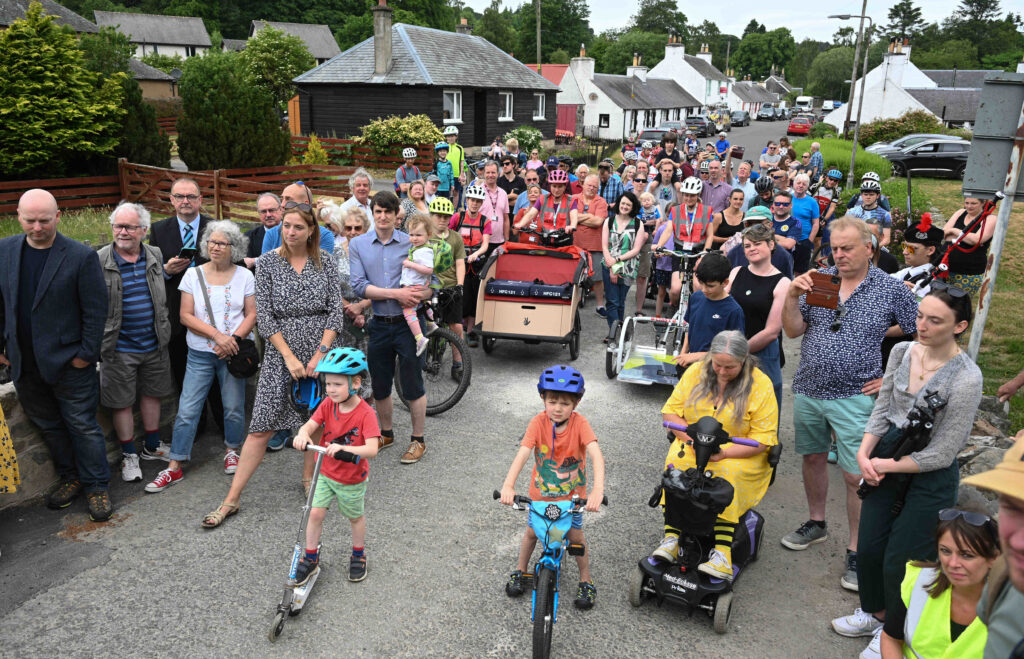
Speaking ahead of the event, Councillor John Greenwell, Executive Member for Roads & Maintenance, said:
“I am absolutely delighted that the new Eddleston Water Path has been completed and that members of the public are now making use of the route.”
“This project has been a true collaborative effort, with thanks to the Scottish Government and SOSE for their financial support in helping make this project a reality and also to the Community Council’s and Trust’s from both Peebles and Eddleston for their support and tireless efforts.”
“A dedicated path will ensure the safety of residents and visitors to the area whilst also encouraging others to choose more active methods of travel between the two settlements.”
Cllr John Greenwell, Scottish Borders Council
Director at Sustrans Scotland, Karen McGregor, added:
“We’re very pleased the Eddleston Water Path is now open to the public.”
“This new route creates a vital traffic-free space for walking, wheeling and cycling between Peebles and Eddleston, enabling residents and visitors to the area to travel actively while accessing key services and local greenspace.”
“We hope the new path makes it safer and easier for lots more people to leave the car at home for short everyday journeys.”
Karen McGregor, Scotland Director, Sustrans
SOSE Chair, Professor Russel Griggs, said:
“SOSE is committed through all we do to supporting a Wellbeing Economy and all the positive things that it brings for communities.”
“The new Eddleston Water Path is a fantastic example of this approach, encouraging local people and visitors to get active and help address issues such as fuel poverty and community isolation and improve resident’s health and wellbeing.”
Prof Russel Griggs, South of Scotland Enterprise
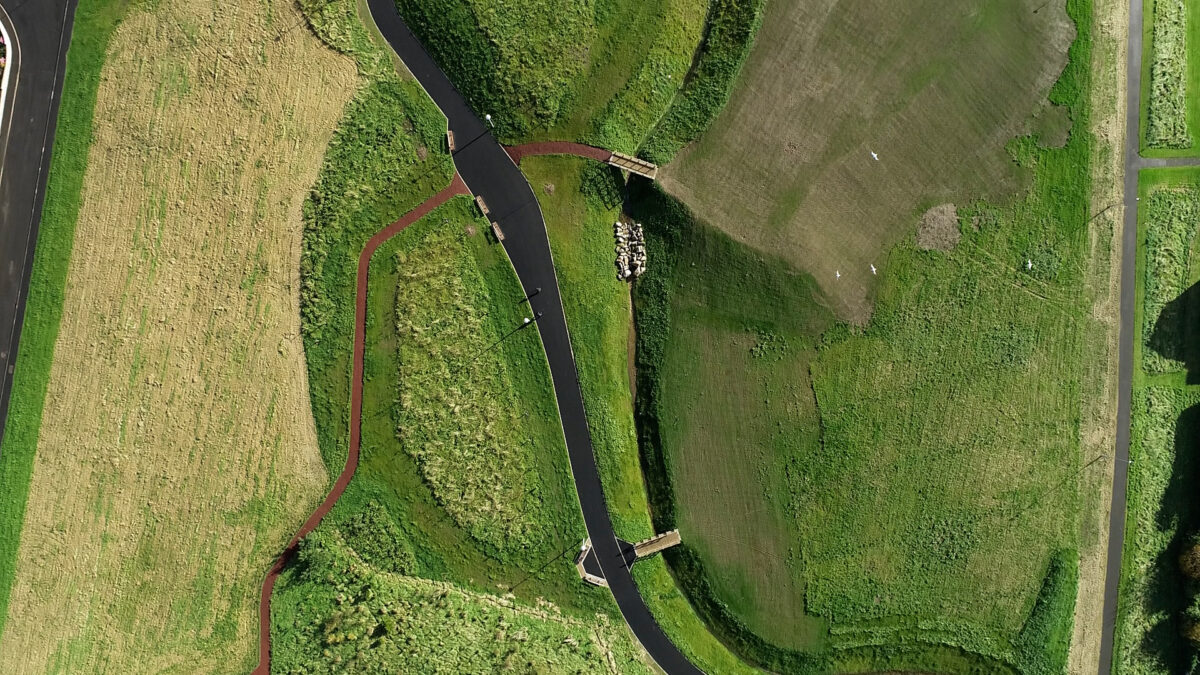
Neighbourhood biodiversity
Located in a residential area to the east of the town, Papdale Park encompasses a sprawling network of meandering paths and modern landscaping initiatives that have truly transformed the space for the better.
Delivered by Orkney Islands Council in partnership with Sustrans through Places for Everyone, Papdale Park provides the Kirkwall community yet another place to enjoy for the year ahead.
Key features of the park include a deculverted burn, an array of walking, wheeling, and cycling routes, as well as native shrubs and trees, and a wildflower meadow for enhanced biodiversity.
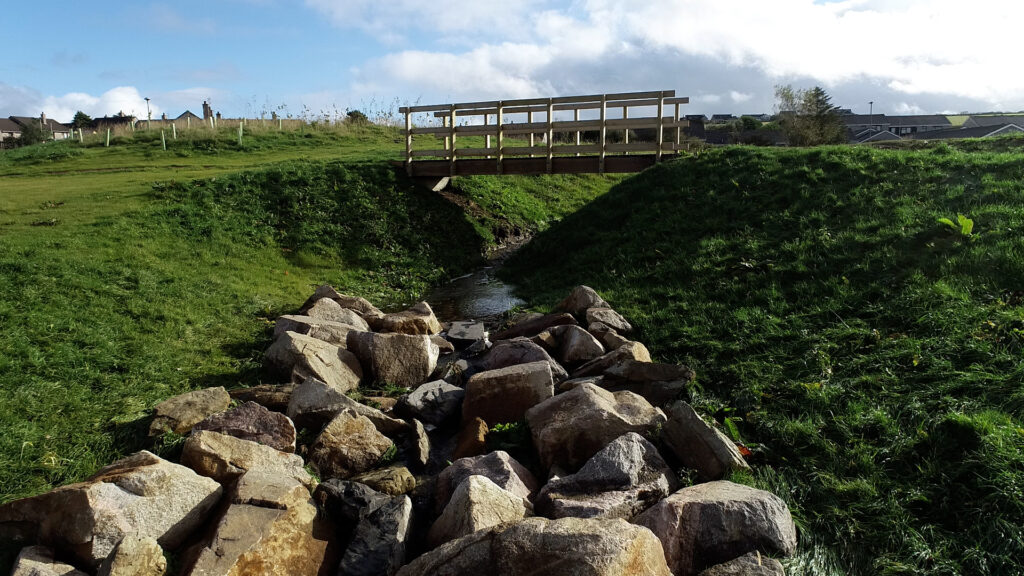
This is topped off with a stunning community plaza and new road crossing linking the park to Kirkwall Grammar School to ensure trips are as safe and accessible as possible.
Further excitement still awaits, however, as this only marks the completion of the first phase of the Papdale Park project.
Once funding is secured through Places for Everyone for the second phase of work, plans can begin to take shape for the creation of an all-ages-and-abilities play park for local residents to enjoy.
A community vision
Plans for the Papdale Park originated from a series of engagement sessions held in 2018, delivered by Orkney Islands Council as part of the Your Kirkwall Place Plan.
During these sessions, local community group Papdale East Play Association (PEPA) brought forward a range of ideas on how to improve the existing but dilapidated play park, complementing neatly with the wider aspirations of the community.
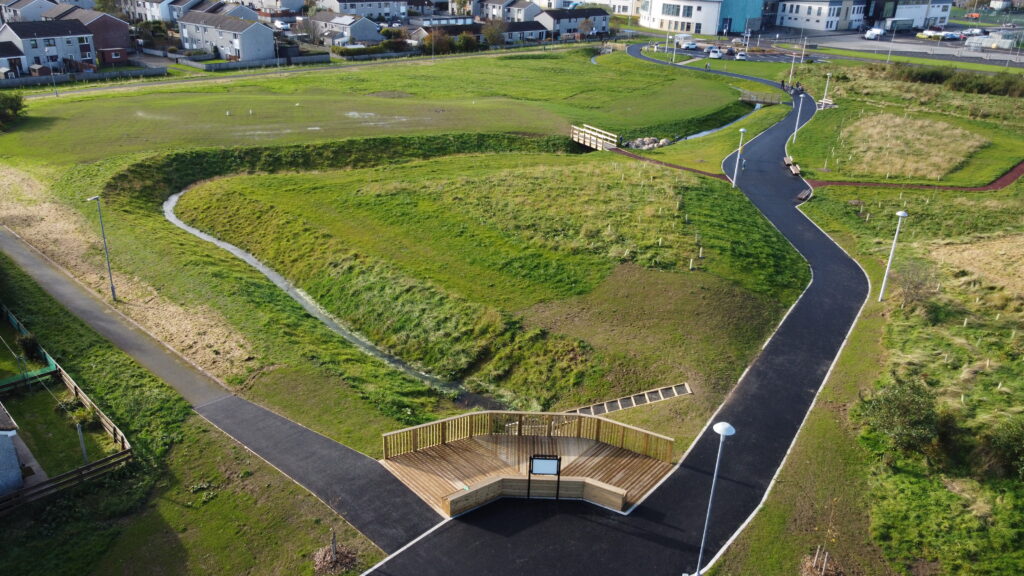
The project was also borne out of the Council’s Play Area Strategy, which identified Papdale East as an area where opportunities for play were in need of improvement.
On these solid foundations, emerging plans were then carefully shaped in accordance with considered community feedback in order to ensure the best design possible was ultimately produced.
The resulting blueprints laid out an ambitious vision for a new community greenspace for people of all ages to enjoy, smartly futureproofed against the impacts of climate change, changing technology, and an anticipated rise in active travel.
A memorable occasion
Despite being informally open since the end of last year, local Orcadians turned out in good number to see the ribbon cutting and Papdale Park officially opened.
Held on Friday 21st April, a series of speeches and guided ecology walks were available to those in attendance. Free cycle servicing and an e-bike display were also provided to attendees.
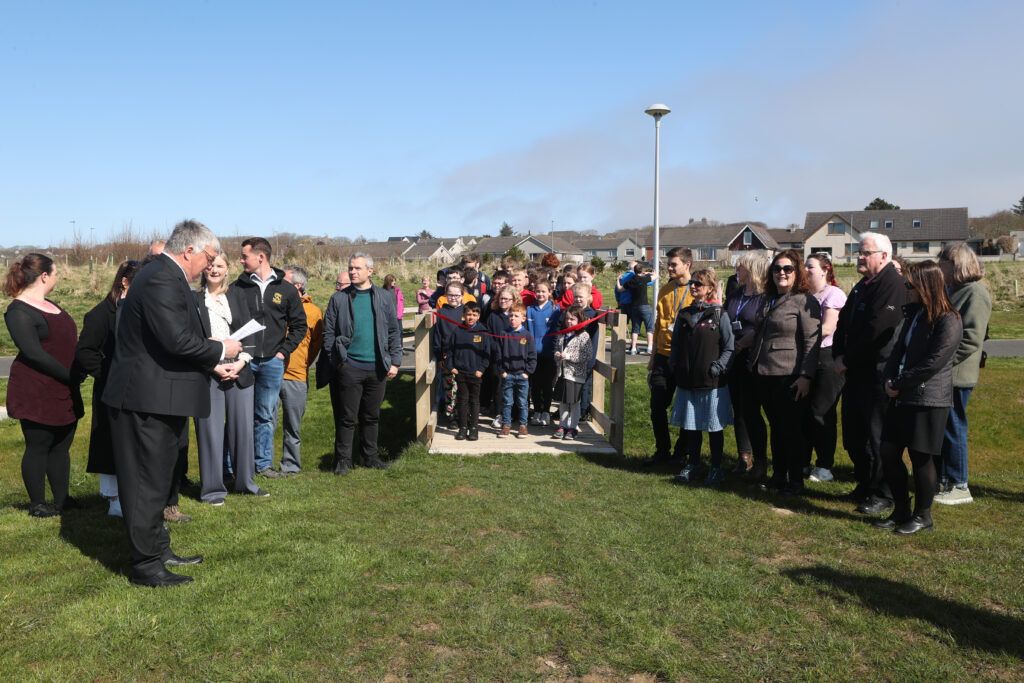
PEPA, who were instrumental in the design and engagement of the Papdale Park project, were also on hand to provide refreshments, a bake sale, and a special treasure hunt.
Karen McGregor, Scotland Director at Sustrans, was delighted with the collective effort that went into making the park possible. She said:
“Papdale Park is a project designed by and for the local community, which is what underpins its success.
At every step and pedal of the way, we engaged closely with residents to find out what they wanted and how they wanted it.
We are grateful for all the input received and look forward to seeing work continue to ensure Papdale Park remains a much-loved local landmark for generations to come.”
Karen McGregor, Scotland Director, Sustrans
The ribbon itself was cut by Orkney Islands Council Convener Graham Bevan. Flanked by pupils attending from Papdale Primary School, he said:
It is an honour to be asked to perform the official opening of this new, much improved community park space within Kirkwall which is for everyone to enjoy.
“It is so important to retain green spaces within our towns as we all know how important getting outdoors, enjoying some fresh air, exercise, greenery and wildlife is to our physical and mental wellbeing.”
Graham Bevan, Convener, Orkney Islands Council
Building on success
Papdale Park marks the third major project to be delivered on Orkney in quick succession through Places for Everyone.
The Places and Spaces project helped deliver key street layout changes to make getting in and around Kirkwall town centre safer and easier.
Sustrans also worked closely with Orkney Island Council to complete the development of the Arcadia Park, which provides an attractive path network and landscaped link to Balfour Hospital to the south.
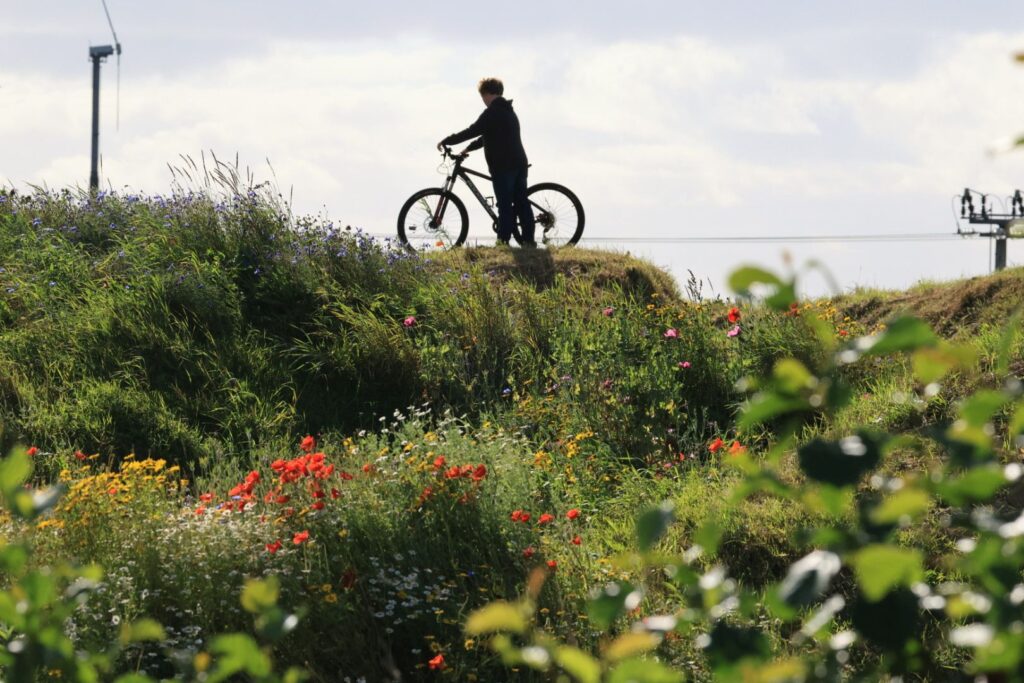
£670,000 was allocated for the Papdale Park project, provided by Orkney Islands Council, NatureScot’s Biodiversity Challenge Fund, and Places for Everyone, an active travel infrastructure programme funded by the Scottish Government and administered by Sustrans.
Additional funding for the project came from a Cycling, Walking and Safer Routes grant allocation and the Scottish Government’s Nature Restoration Fund. Design work was funded by HITRANS.
The project has also been supported by the Orkney Woodland Project and The Woodland Trust and the work carried out by Andrew Sinclair Contractors.
Already becoming a cherished community asset, Papdale Park is yet another success story for active travel opportunities in Kirkwall.
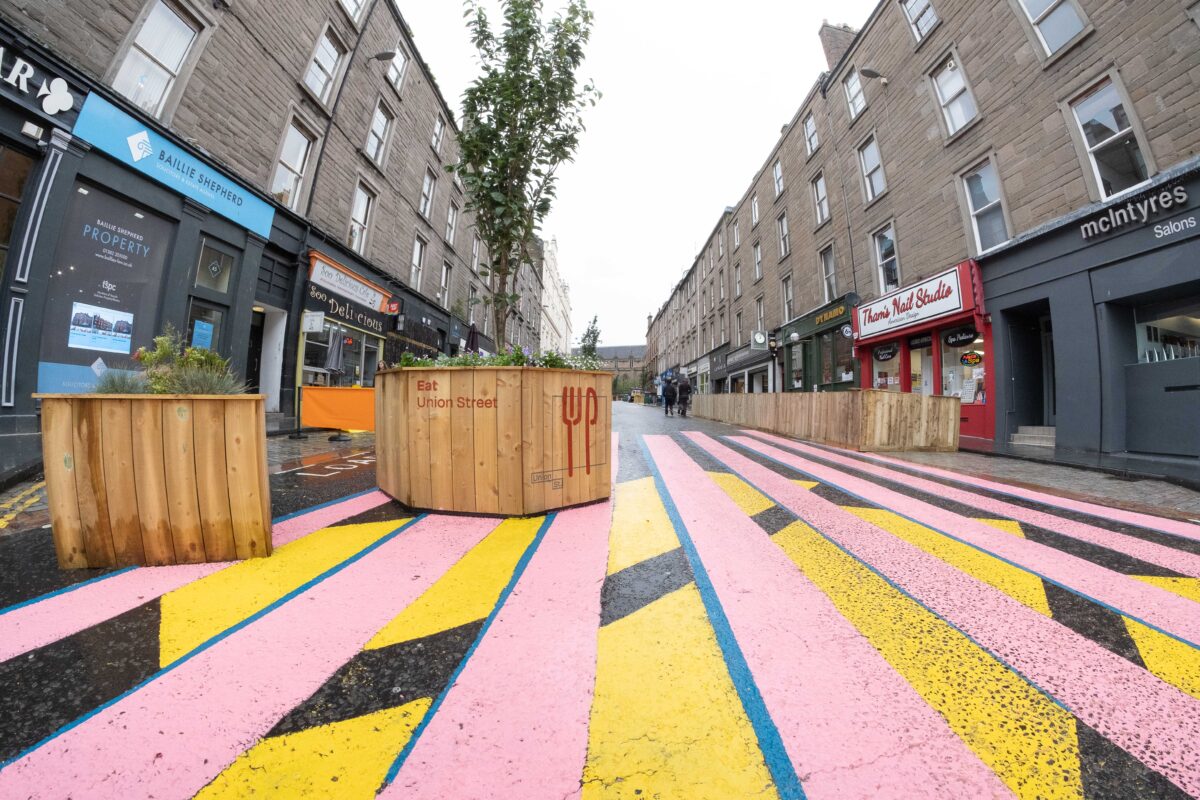
Sustrans is the charity which makes it easier for people to walk, wheel and cycle for more of their everyday journeys.
Supported by Transport Scotland, we provide funding and expertise to help deliver walking, wheeling and cycling improvements across Scotland.
Spaces for People was a flagship Scottish Government programme launched at the start of 2020 early in the COVID-19 pandemic to enable people to make essential journeys and exercise during lockdown.
Funded by the Scottish Government and managed by Sustrans Scotland, the £33 million fund was made available to local authorities and other statutory bodies to introduce temporary infrastructure across Scotland.
The infrastructure was introduced to protect public health and alleviate the effects of lockdowns.
Short term measures included widened pavements, pop-up cycle lanes and reduced speed limits.
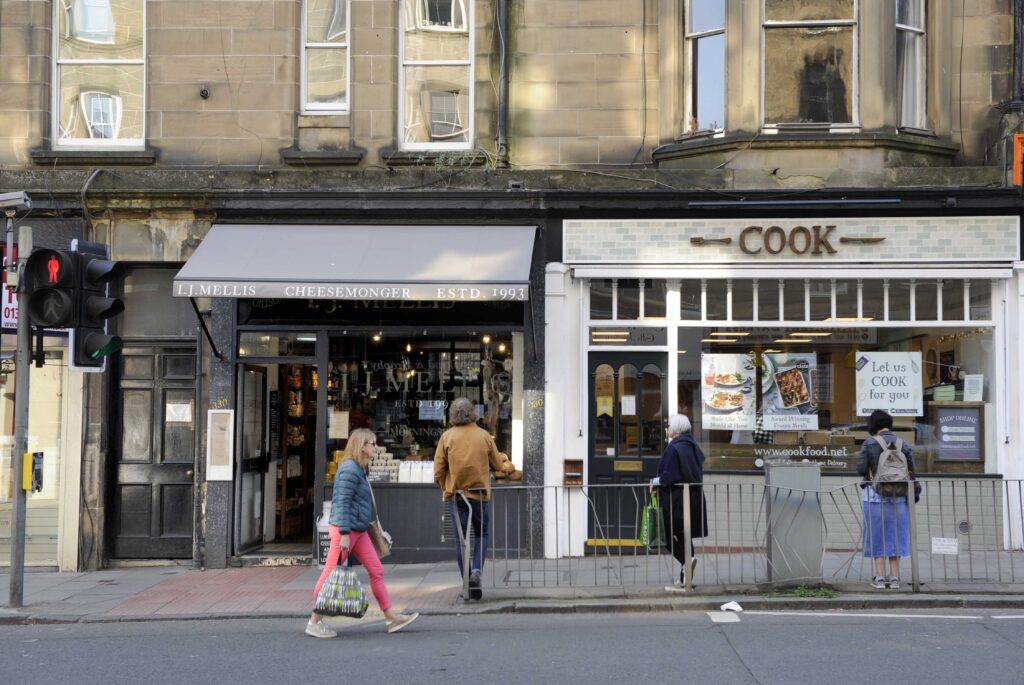
These interventions allowed people to physically distance more easily.
The interventions also helped maintain safe access to essential services such as healthcare, food or education services without using public transport.
The reports released provide insights on the extent to which Spaces for People achieved its overall aims as well as how those with protected characteristics were impacted by the programme.
The report also highlights key learnings and recommendations to be taken forward.
In total, 30 local authorities, 3 NHS trusts and TACTRAN took part in the programme, with each delivering their own projects.
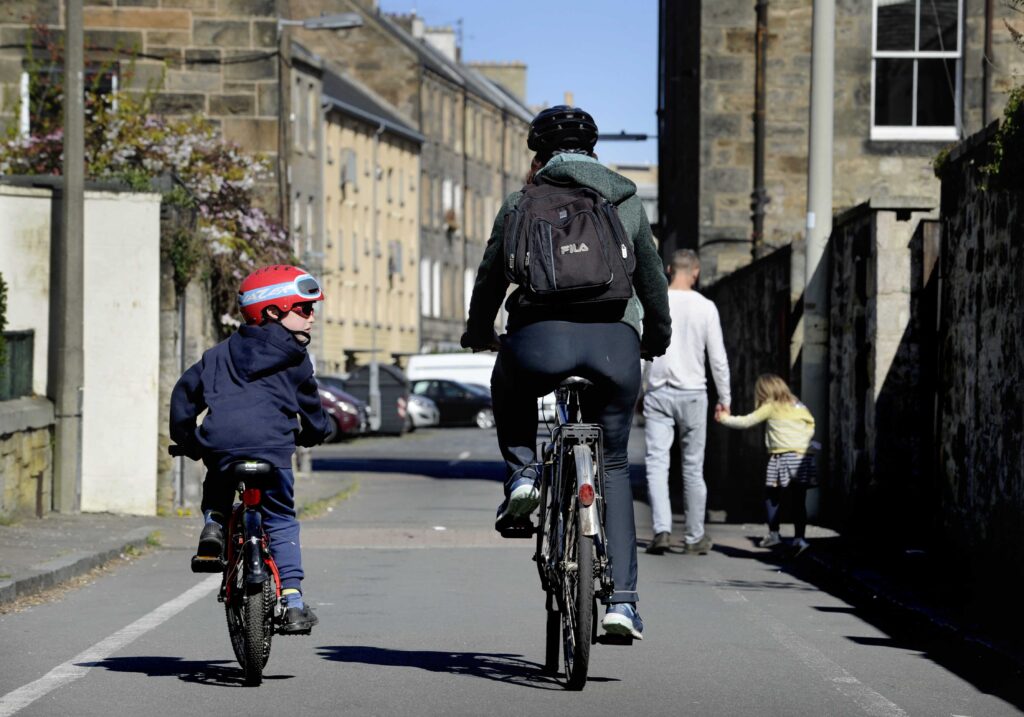
Together, this resulted in the implementation of 1,298 interventions in a 2-year period.
This is an unprecedented rate of delivery within the sector.
Public support
Findings show that walking and cycling increased across Scotland while temporary measures were in place.
The reports also show that public reception of the programme was generally more positive than negative.
Success of the programme
One of the key successes of the programme is the large number of temporary Spaces for People measures which have contributed to longer-term plans or new active travel projects in the area.
This includes the closure of the Kelvin Way in Glasgow to motor traffic, and the people-first pedestrianisation of Union Street in Dundee that has benefitted many local businesses in the area.
Interventions which have served their purpose and are no longer seen as relevant by communities are currently in the process of removal, if not removed already.
This was the intention of the programme from the outset.
Lessons to be learned
Whilst the broader aims of protecting public health and facilitating essential journeys during the pandemic were largely met, a number of key lessons have been taken from the delivery of the programme.
Lack of availability of materials early in the pandemic meant that local authorities often had to rely on poorer quality and visually unappealing materials, such as traffic cones, to deliver temporary measures.
This was later rectified in some areas through the use of more welcoming fixtures, such as wooden community planters.
Feedback collected by Sustrans also highlighted that improved engagement with disability groups in addressing their concerns could have increased the overall success of the scheme.
The learnings from the research will now be fed into a process of learning and continuous improvement over the coming months through a series of engagement sessions and workshops with delivery partners.
“Spaces for People was an emergency response to the global pandemic – across the world, in places like New York, Paris and Berlin, streets were reshaped to meet the big shift in public demand for safer walking, wheeling and cycling.
These welcome reports from Sustrans Scotland show that many of the Scottish schemes have been successful and local authorities are choosing to make them permanent.
At the same time, delivering schemes swiftly and at scale raised issues that we can all learn and build on as we consider new permanent infrastructure.
The active travel landscape has improved much since Spaces for People was first announced.
Funding for active travel is now at record levels and set to increase further in future years, and we will work with partner organisations to ensure that inclusive design and accessibility is embedded in designs from the outset”.
Patrick Harvie, Minister for Active Travel
“Spaces for People was an enormous undertaking during what was an unprecedented time for all of us.”
“We are immensely proud of the successes it has achieved.”
“The temporary measures delivered through the programme ensured people across Scotland could safely distance from one another when making necessary journeys to key workplaces, schools, supermarkets and healthcare sites.”
“We are hugely appreciative of our delivery partners for their tireless work throughout the pandemic to make sure temporary measures were implemented both swiftly and safely.”“We’d also like to thank Transport Scotland for providing the funding to facilitate the Spaces for People programme.”
Karen McGregor, Scotland Director, Sustrans
“The Spaces for People programme showed the importance of collaboration and communication between the multiple partners responsible for delivering safe and accessible active travel infrastructure in Scotland.”
“SCOTS and our local authority members have been delighted to support the programme and its evaluation.”“We look forward to embedding the lessons learned in developing best practice and continuing our collaborative active travel partnerships.”
Chair of SCOTS, Walter Scott
You can find further information about the programme on our dedicated Spaces for People Showcase webpage, as well as the reports and key learnings below.
Spaces for People Evaluation Report
Spaces for People Evaluation Report (Easy Read)
Spaces for People Evaluation Report (Appendices)
Spaces for People Equalities Report
Spaces for People Equalities Report (Easy Read)
Spaces for People Lessons Learned
Spaces for People Equalities Report (Easy Read)
British Sign Language (BSL) versions of the report executive summaries are available upon request from our Places for Everyone team at PlacesForEveryone@sustrans.org.uk
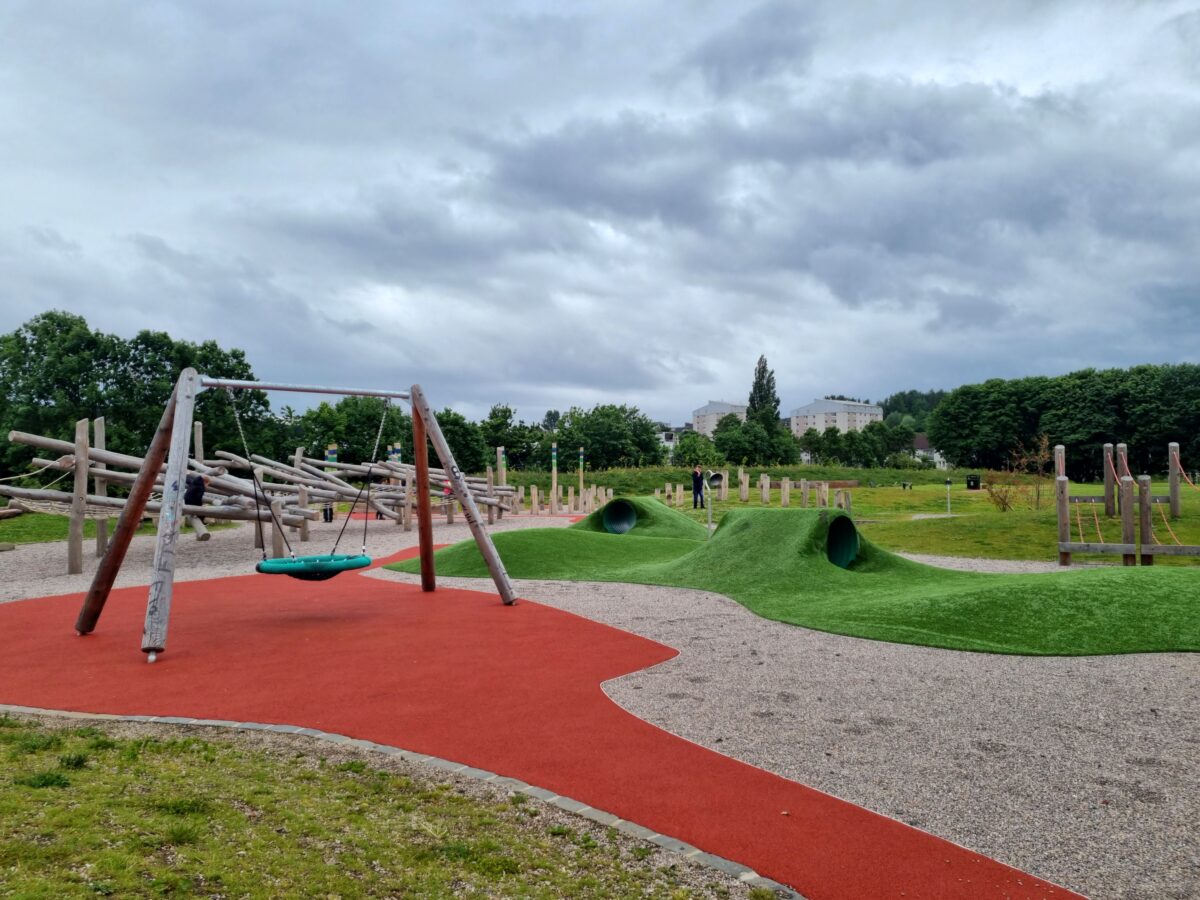
In June 2022, opening celebrations were held for the new path network in the Toryglen area of Glasgow that will make walking, wheeling, and cycling more accessible.
The project forms part of a much larger multi-million-pound regeneration of the Malls Mire woodland in the southside of the city, known as the Malls Mire Woodland Regeneration Project.
The creation of this fantastic community space was possible thanks to the collaboration of Sustrans, Clyde Gateway, Urban Roots, Nature Scot and Idverde landscaping services.
At the launch event we caught up with members of the local community and those responsible for bringing the project to fruition to hear about the positive impacts the regeneration has had on the area.
What is Malls Mire?
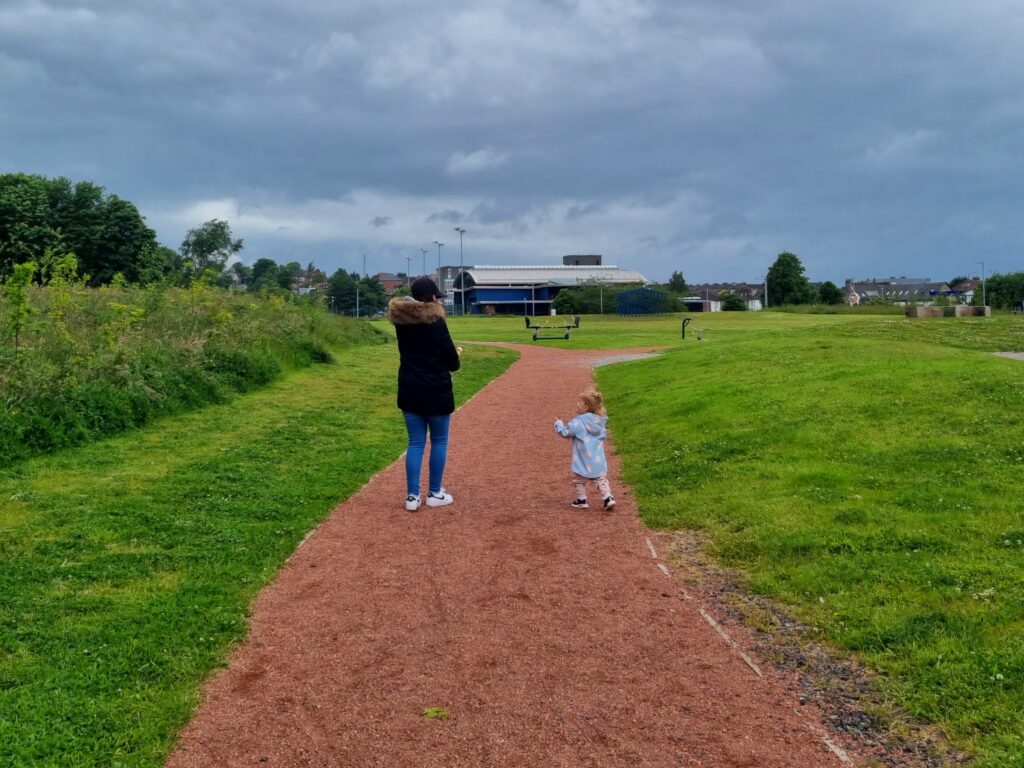
The Malls Mire Woodland Regeneration Project has created an urban oasis between Toryglen and Rutherglen in the southside of Glasgow.
What was once 15.7 hectares of derelict land is now home to a mixed-use park, wetland, nature reserve and woodland.
These features are all connected by a network of routes that run throughout the site.
The space offers both local and wider communities somewhere they can use for exercise, volunteering and education as well as unwinding in nature.
Malls Mire was the first Community Woodland in Glasgow and became a Local Nature Reserve in 2015.
Inspiration behind the project
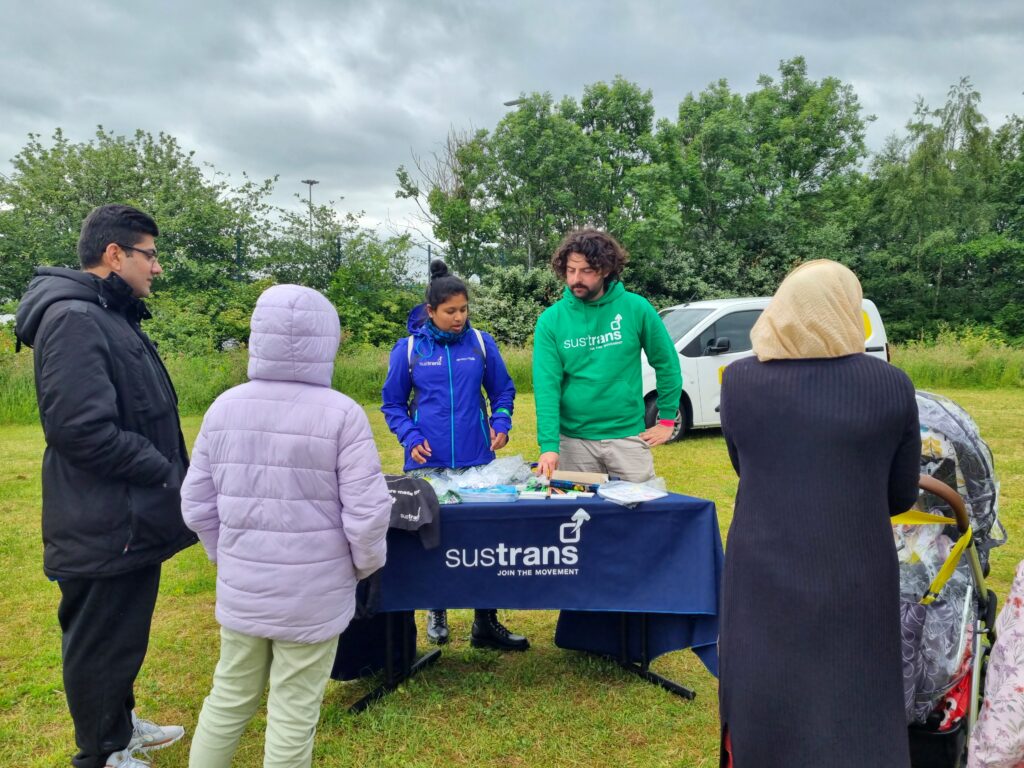
Connecting people with the natural world leaves them feeling happier and healthier.
In Toryglen, local people identified an opportunity to create a place where everyone could enjoy these benefits right on their doorstep.
This project has stemmed from many years of community and volunteer engagement to regenerate the land into a beautiful greenspace.
“This is a transformational regeneration area where there used to be old high-rise flats down to the east.
As the new housing developed there were spaces left, and with that came a big push to try and improve the greenspace.
If you only improve the housing but not the things in between it, you are potentially creating a problem and doing a disservice to the community”
Dougie Cameron, Project Manager, Clyde Gateway
Delivering Malls Mire
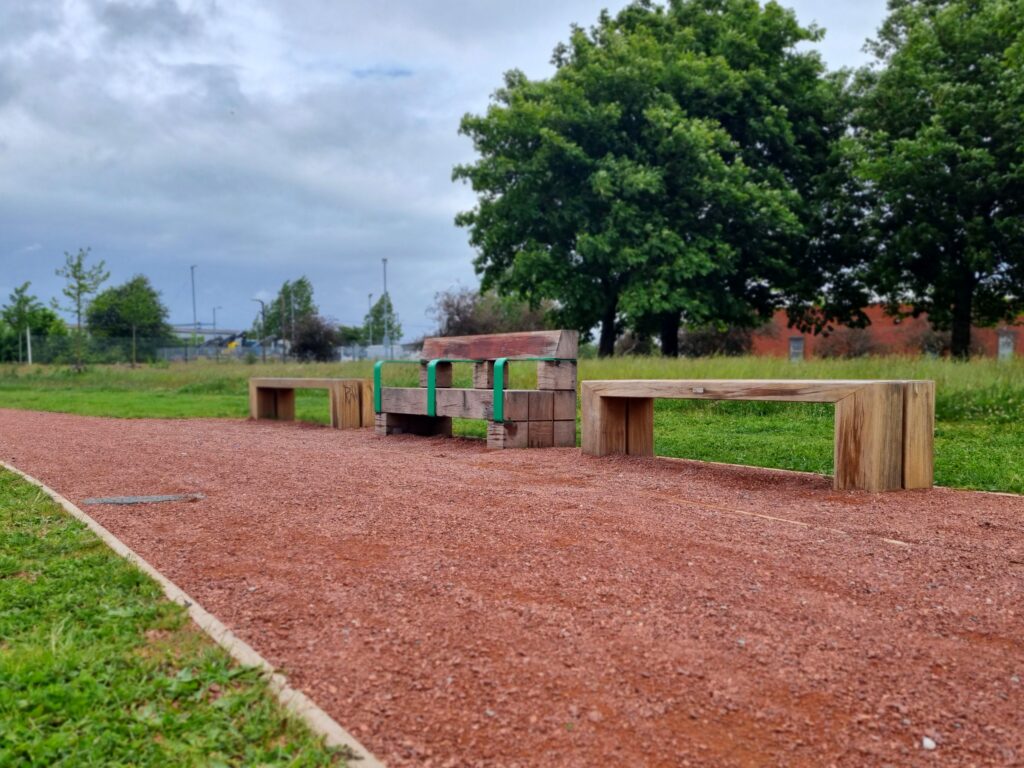
Urban Roots – a community led environmental charity working across the southside of Glasgow – have been involved with the project since 2009.
In 2018 they embarked on a Green Infrastructure Community Engagement Fund project called Growing Connections.
By working together with Sustrans, Clyde Gateway and Glasgow City Council this developed into a more ambitious vision for the area, including the design of an active travel strategy for North Toryglen.
The local community were involved at every stage of the project and inputted at a number of engagement events over the years.
Construction work began in November 2020 and completed a year later.
A lasting impact
Malls Mire officially opened to the public in June 2022 at an event that was attended by the local community, partners and politicians.
At the launch, community members were reflective about their memories of growing up in Toryglen.
Reflecting on how the area has changed, one local resident told us:
“When we were younger there was nothing for us to do except from hanging around the streets and causing trouble.
Now the kids have this opportunity so close to hand – in a scheme like this that had nothing back in the day.It’s brilliant, brilliant – a big change!”
Local resident, Toryglen
Emily Gait, Grant Manager for Sustrans, was equally positive about the completed project, stating:
“We are so excited to see the completion of the new path network in the Malls Mire woodland, and to celebrate its opening with the local community who have supported us throughout the project.
These works have delivered an accessible space where everybody living in the area can safely enjoy being active and spending time outdoors.
Routes such as this are such an important step into empowering more people to walk, wheel, and cycle.”
Emily Gait, Grant Manager, Sustrans
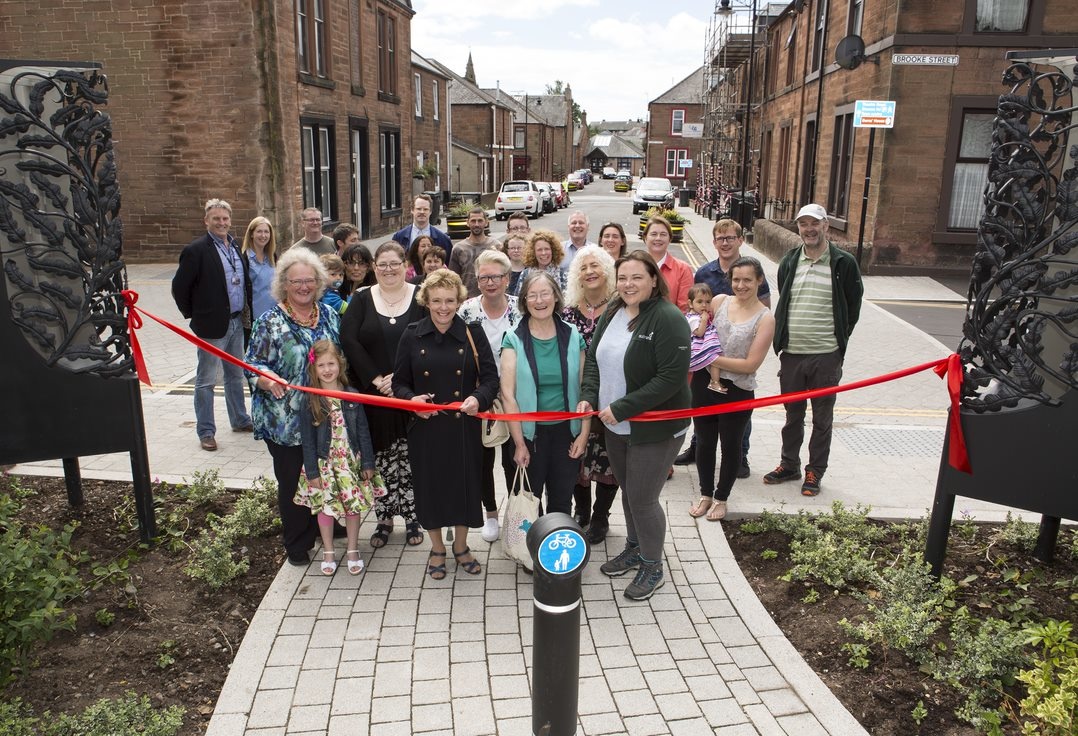
The Dumfries Neighbourhood Street Design project transformed a once-neglected part of Dumfries town centre into a vibrant and high-quality pedestrianised space for people to walk, wheel and cycle.
Developed jointly by residents, Sustrans and Dumfries and Galloway Council, the project was delivered in response to longstanding concerns over traffic movement in the Queen Street neighbourhood of Dumfries.
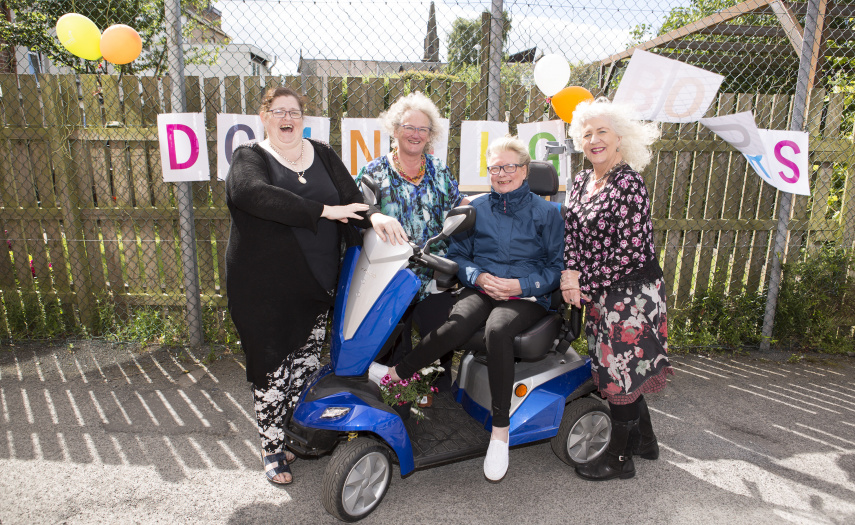
People living and working in Queen Street, McLellan Street, Brooke Street and Cumberland Street closely guided the changes carried out in their neighbourhood from initial design ideas through to the construction process.
This resulted in the installation of innovative artwork, traditional Victorian street lighting, gateways and a touch of greenery in the form of trees and planters.
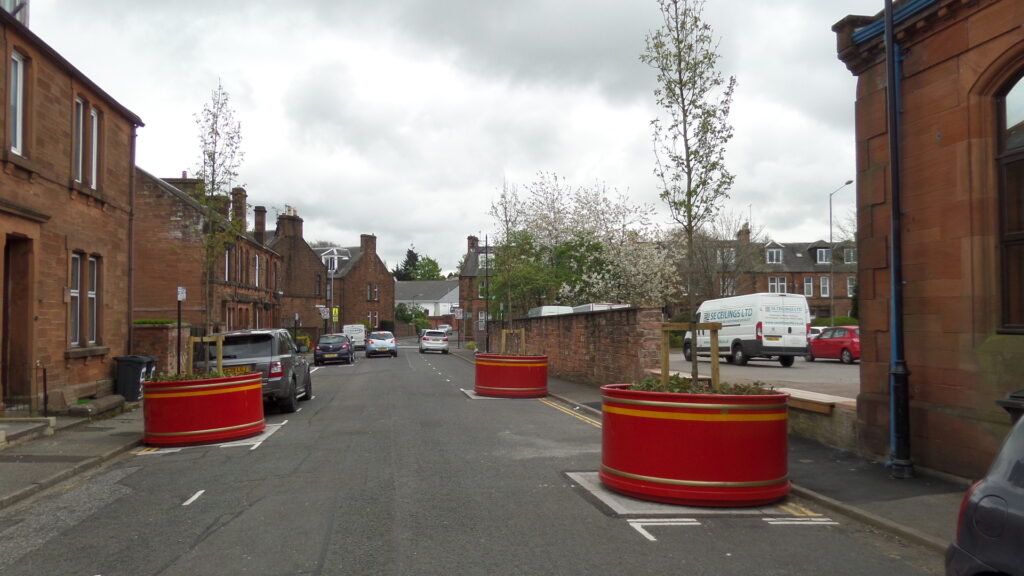
The project also saw changes made to the road layout of all four streets and the area outside Theatre Royal on Shakespeare Street, including the addition of raised tables, wider pavements and street furniture.
This helped make the streets safer and more attractive for people to walk, wheel and cycle.
A collaborative effort
The team at Sustrans worked closely with the local community at each stage of the project to deliver the community’s vision for their local area.
A variety of engagement methods were used, including competitions, workshops, on-street consultations, guided bike rides, pop-up installations, and a ‘Big Lunch.’
The activities were specifically designed to bring people together, to inspire long term interest in their neighbourhood, to strengthen social connection and empowerment, and to co-design solutions.
During the project, residents of the area decided to form a constituted community group, DG1 Neighbours, which continues to undertake neighbourhood improvements even after the initial project was itself completed, such as the creation of a community garden.
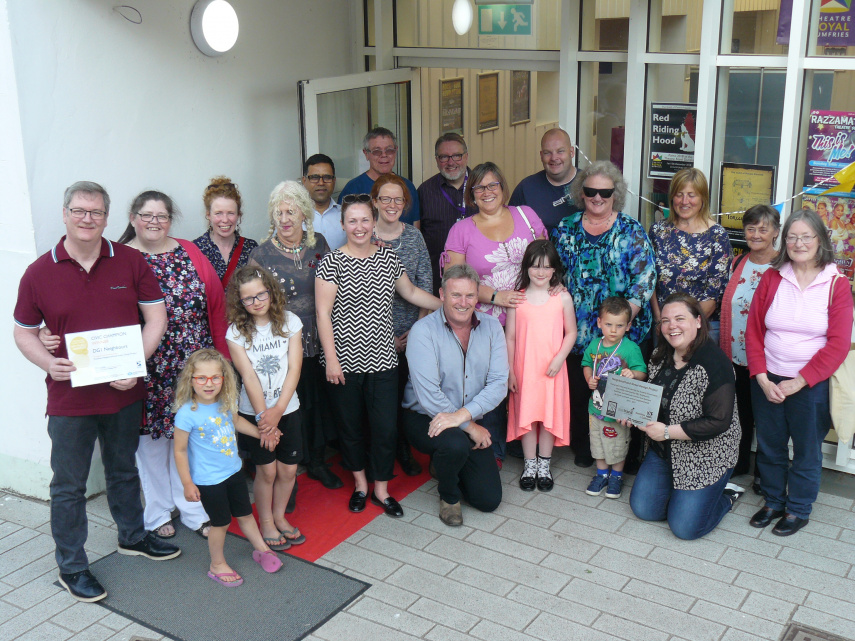
Sustrans’ aim was to build up trust and learn about the community – getting people out of their houses, meeting their neighbours and bringing them together.
This approach achieves far more than better street design: it gives communities a sense of empowerment, momentum, and community cohesion.
Voices from the team
Paul Ruffles, Principal Designer at Sustrans Scotland said:
“This is a benchmark project for high quality collaborative design. This project showcases what can be achieved when communities and partners to work together to build ambition and implement visions for the places they live in.”
“As a result of this project the neighbourhood has become a greener, quieter space with a strong character that celebrates the areas heritage and actively encourages people to spend time in or walk, wheel or cycle through.”
Local community group DG1 Neighbours added:
“It’s great to see the positive changes that have taken place over the past few years in our neighbourhood and the celebration event helped to remind everyone of the transformation.”
“Thanks to Sustrans and Dumfries and Galloway Council for their determination to see the project through to the end. More residents are taking pride in the neighbourhood and they are even starting to adopt the on-street planters.”
“We now look forward to formalising our community group and building on the successful outcomes of this project.”
The project was jointly funded by Dumfries and Galloway Council and Sustrans with funding from Transport Scotland.